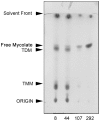Non-replicating Mycobacterium tuberculosis elicits a reduced infectivity profile with corresponding modifications to the cell wall and extracellular matrix
- PMID: 24516549
- PMCID: PMC3916317
- DOI: 10.1371/journal.pone.0087329
Non-replicating Mycobacterium tuberculosis elicits a reduced infectivity profile with corresponding modifications to the cell wall and extracellular matrix
Abstract
A key feature of Mycobacterium tuberculosis is its ability to become dormant in the host. Little is known of the mechanisms by which these bacilli are able to persist in this state. Therefore, the focus of this study was to emulate environmental conditions encountered by M. tuberculosis in the granuloma, and determine the effect of such conditions on the physiology and infectivity of the organism. Non-replicating persistent (NRP) M. tuberculosis was established by the gradual depletion of nutrients in an oxygen-replete and controlled environment. In contrast to rapidly dividing bacilli, NRP bacteria exhibited a distinct phenotype by accumulating an extracellular matrix rich in free mycolate and lipoglycans, with increased arabinosylation. Microarray studies demonstrated a substantial down-regulation of genes involved in energy metabolism in NRP bacteria. Despite this reduction in metabolic activity, cells were still able to infect guinea pigs, but with a delay in the development of disease when compared to exponential phase bacilli. Using these approaches to investigate the interplay between the changing environment of the host and altered physiology of NRP bacteria, this study sheds new light on the conditions that are pertinent to M. tuberculosis dormancy and how this organism could be establishing latent disease.
Conflict of interest statement
Figures











References
-
- Ulrichs T, Kaufmann SHE (2006) New insights into the function of granulomas in human tuberculosis. J Pathol 208: 261–269. - PubMed
Publication types
MeSH terms
Substances
Grants and funding
LinkOut - more resources
Full Text Sources
Other Literature Sources
Miscellaneous

